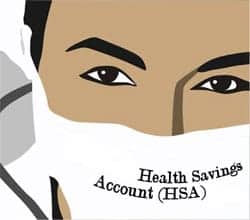A year or so ago I first wrote about Health Savings Accounts because the company I work for was considering moving all of the employees to a High Deductible Health Plan (HDHP) in conjunction with a HSA. For the company it was a more affordable option since the premiums are lower. Our company has had a poor health history, and as a result, our company has had to pay pretty high premiums for all of the employees. Because of that they’ve been looking for ways to cut back.
In the past my wife and I have used a traditional health plan in conjunction with a Flexible Spending Account (FSA) for our health care. My wife has had a lot of health issues, and going with the HSA and High Deductible Health Plan would have been cost prohibitive given her health history and the higher deductibles we would have had to cover.
Next year we’ve been told that we’ll be moving to a Health Savings Account with a High Deductible Health Plan whether we like it or not, so today I thought I’d take a look at the 2013 limits for health savings accounts.
Quick Navigation
What Is A Health Savings Account

Typically you can use your HSA to pay for things like deductibles, co-insurance and in some cases health insurance premiums.
Health Savings Accounts are a great way to save on your tax bill at the end of the year because you’re contributing money to your account before taxes, so that money is never taxed. The money in the account can also grow with no taxes on earnings, and can be spent on eligible medical expenses with no taxes taken out down the road.
The HSA is usually used in concert with a High Deductible Health Plan, so having one also usually means your premium is lower. These plans work especially well for people who are in good health, or don’t expect to have a ton of medical bills. They can put money away to pay for future expenses, and watch it grow.
Eligibility For Opening A HSA
To be eligible to open a HSA, you must meet the following criteria.
- You must be covered by a High Deductible Health Plan (HDHP).
- You can’t be covered under another medical health plan that isn’t a HDHP.
- You can’t be entitled to Medicare benefits.
- You can’t be claimed on another person’s tax return.
- You can’t be eligible for Tricare or have received benefits from the Veteran’s administration in the past three months.
For most people, the main requirement from the above eligibility guidelines is that you must have a High Deductible Health Plan in order to have a Health Savings Account.
How Much Can I Contribute To My HSA In 2013?
HSAs are similar to FSAs in that they have limits as to how much you or your employer can contribute in a calendar year. The 2013 HSA annual contribution limits are:
- Individual Coverage Contribution Limit: $3,250
- Family Coverage Contribution Limit: $6,450
Individuals who are 55 or older may be eligible to make a catch-up contribution of $1,000 in 2013.
The maximum contribution amount for an individual went up by $150 over the 2012 maximum, and for a family it went up by $200.
Health Savings Accounts are used in concert with a High Deductible Health Plan as mentioned above. Let’s take a look at some basics of those plans.
Basics Of A High Deductible Health Plan
A High Deductible Health Plan (HDHP) is basically an insurance plan that has a higher deductible, and higher maximum out of pocket cost than a traditional plan. With one of these plans you’re expected to cover more out of pocket costs up front, with the return of lower premiums and tax savings via HSAs. HDHP are basically there to cover catastrophic health events. The Treasury explains HDHP like this:
You must have an HDHP if you want to open an HSA. Sometimes referred to as a “catastrophic” health insurance plan, an HDHP is an inexpensive health insurance plan that generally doesn’t pay for the first several thousand dollars of health care expenses (i.e., your “deductible”) but will generally cover you after that. Of course, your HSA is available to help you pay for the expenses your plan does not cover.
The IRS issues yearly guidance on High Deductible Health Plans in regards to an annual deductible minimum (amount you must pay before insurance kicks in), and a maximum out of pocket cost.
For the calendar years of 2013, the minimum deductibles and out of pocket maximums for a HDHP are as follows:
| High Deductible Health Plan Requirements | 2019 | 2020 | 2021 |
|---|---|---|---|
| Minimum Annual Deductible Individual | $1,350 | $1,400 | $1,400 |
| Minimum Annual Deductible Family | $2,700 | $2,800 | $2,800 |
| Maximum Annual Out Of Pocket Individual | $6,750 | $6,900 | $7,000 |
| Maximum Annual Out Of Pocket Family | $13,500 | $13,800 | $14,000 |
So in other words, in order to have insurance coverage kick in, an individual must pay at least a minimum of the first $1,250 in costs, or for a family – $2,500. After that there will be co-insurance up to the maximums listed. Of course your plan may have higher minimums, and lower maximums.
Withdrawals From Your Health Savings Account
Withdrawals from a Health Savings Account are tax free when they’re used for eligible health care expenses. That’s one reason why they’re so great, the tax savings!
Depending on your particular HSA, you’ll withdraw money usually in one of the following ways:
- Debit card: Some accounts will just supply a debit card that you use to pay expenses directly from your HSA.
- Check: Some will require you to write yourself a check when expenses come up, that you can then deposit in your account to pay for the expenses.
- File paperwork: Sometimes you’ll need to file paperwork for the expenses to have them reimbursed, similar to with a FSA account.
Withdrawals that you make for things other than approved medical expenses will be taxed at your regular rate, and will also be subject to a 20% penalty. If you have reached the age of 65 or are disabled, the penalty disappears, so some folks have used the HSA as another way to save for retirement, similar to an IRA.
Other HSA Resources
- Health Savings Accounts and Other Tax Favored Health Plans: IRS .pdf on the topic.
- HSA – Wikipedia explanation of Health Savings Accounts
- HSA frequently asked questions: From the US Treasury.




I had a HSA through my former employer and loved it since we could carry over the balance. We’re self-employed now and are in the process of getting one set up for our medical expenses.
That is definitely one of the big bonuses of the HSA, being able to carry over a balance from year to year and watch the money grow. For some people who are in good health it can lead to a nice big balance by the time they retire – at which time they can withdraw if they want to and just pay their normal tax rate.
We have a traditional plan currently, and we use a FSA with that. Unfortunately the FSA is a spending account, and you have to spend it in full every year or lose it. HSA rolls over and you can use it when you need it. Much better.
Some employers are now combining an HSA with supplemental insurance which helps fill the deductible gap. Cash benefits are paid to the insured.
It allows people to tailor choices with needs. A family planning children might select a hospital indemnity plan. A family with kids in sports might pick an accident policy.
Combined premiums are still lower, but the exposure is less.
I am contributing the maximum allowed. I love my HSA and if I continue in this job and if we don’t hit our out of pocket max every year, I hope to build up my HSA balance.